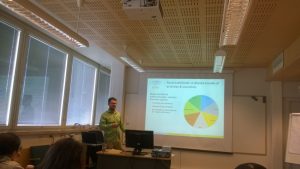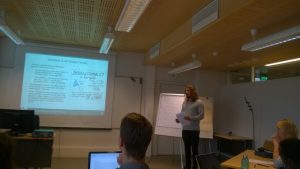It is already 15 days in Finland and we are gradually drawing closer to the end of the short course- Managing Sustainable Forest Landscape. The weather was generally cold as compared to other days.
The day started with Dr. Hogarth giving us insight into forest and livelihoods in the Global South. After acquainting himself with all participants and introducing himself to the class, lecture began. We were made to understand that even though Agricultural Revolution started 12,000 years ago, rural people across the Global South still derived as much income from forest and wild lands as from cultivating crops. We looked at definitions, forest livelihood on global stage, role of forest in livelihood and poverty, empirical evidences and methods and tools for collecting forest livelihood data. Forest livelihood was defined as a means of securing the basic necessities of life such as food, water, shelter and clothing from the forest. It is generally revealed that ‘where there is rich forest, there is poverty’. The three types of people-forest relationship that exit are the total dependent on the forest for livelihood, people who live near the forest and use products partly for subsistence and income generation and the last group depend on the forest commercially. It was observed from the study that 95% of the value of forest is not from timber as many perceive. Instead the most important forest income sources in Global South are fuel, food and structure & fibre respectively. Currently, 99.6% of income was generated from forest products and only 0.4% from the services of the forest. Averagely, forest contributes 22.2% of household income in the Global south. It was also observed that though both men and women depend on forest products for subsistence, men are more responsible for processed products. Also the Poverty Environment Network (PEN) found that households with medium to high asset holdings and higher market orientation were more likely to clear forest than the poorest and market-isolated households. Dr. Hogarth gave book awards to three participants who gave the closets answers to the exercises given. Julia from England, Cynthia and Michael from Ghana were the award winners.
Right after lunch, Markus Ihalainen from CIFOR took us through Gender and Power relations in forest landscapes. It was explained that there was clear difference between the words ‘Sex’ and ‘Gender’. Whilst sex refers to the biological features of an individual, Gender goes ahead to look at other factors of social differences and inequalities. Gender influences the way in which men and women engage in forest resources. Globally, women participated far less in decision-making and there is a rampant inequality with respect to access and control over productive resources. It is also that women’s exclusion from decision making could result in certain interest, priorities and needs being overlooked. It was also observed that climate change impacted women and men differently. Hence, more must be done to empower women in forest related issues. Some of the students also shared experienced from their various countries to confirm the observed trends though it was admitted that there is a gradual swift though not drastic enough.
Dr Paula Siitonen ended the day with a lecture on Participatory approaches in sustainable landscape management: How to co-create sustainable benefits from the forest landscapes? Hers was a more demonstrative way to presenting what she wanted to teach us theoretically. All through her lectures were practical exercises to explain every step and approach of participatory approaches and it was very much appreciated as things became real to us. She took us through the theories, processes methods of participatory approaches, communication and facilitation skills, materials and techniques to achieve better results. We were made to understand that the success of such approaches mainly depended on the facilitator. One must be skillful enough to steer participatory gathering to the expected result. Facilitator must make conscious effort to get every member to contribute his or her ideas.
Generally, all the lectures for today were more socially oriented and very interactive.
-Cynthia Adjoa Aseba Okine.


